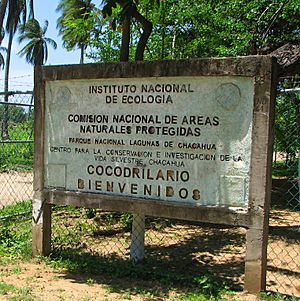Lagunas de Chacahua National Park facts for kids
Quick facts for kids
Designations
|
|
|
Invalid designation
|
|
| Official name: Lagunas de Chacahuan | |
| Designated: | 2 February 2008 |
|---|---|
| Reference #: | 1819 |
The Lagunas de Chacahuan National Park (Spanish: Parque Nacional Lagunas de Chacahua) was created in 1937. It is a national park in the Mexican state of Oaxaca. You can find it in the Municipality of Villa de Tututepec de Melchor Ocampo.
The park is about 54 kilometers (33 miles) west of Puerto Escondido. It is also close to a village called Zapotalito. You can get there by using Federal Highway 200 or by taking a boat from Puerto Escondido. The park is located between the towns of Santiago Jamiltepec and Puerto Escondido.
The park covers a large area of 132.73 square kilometers (about 51 square miles). About 30 square kilometers (11.5 square miles) of this area is made up of different lagoons. Some of these are the Laguna de Chacahua, Laguna de La Pastoria, and Laguna Las Salinas. Many smaller lagoons are connected by narrow channels. The rest of the park is dry land.
Contents
Amazing Nature in the Park
This national park is home to many different types of plants and animals. It has 10 kinds of plant life. These include thorny forests, swamps, and areas with trees that lose their leaves. You can also find tropical broadleaf forests, mangroves, and savannahs. Other plant areas include "bosque de galleria" (gallery forest), "tular" (reed beds), palm trees, and coastal sand dunes.
Scientists have found 246 types of flowers and 189 kinds of animals in the park.
Birds and Other Animals
Many birds live in or visit the park. You might see storks, herons, and wild ducks. There are also blue-winged teals, pelicans, and spoonbills.
Three different kinds of sea turtles come to the park's beaches. They visit to lay their eggs. This is a very important part of their life cycle.
Crocodile Nursery
The park is also a safe place for crocodiles. There is a special nursery for Mexican Pacific coast crocodiles (Crocodylus acutus). Here, young crocodiles are cared for. This helps them grow strong before they are released into the wild.
Exploring the Park
You can take boat tours to see the park's shores and mangrove forests. These tours are a great way to watch the many birds that fish in these waters. The tours often include a stop to try local foods. You can also visit the crocodile nursery during these trips.
See also
 In Spanish: Parque nacional Lagunas de Chacahua para niños
In Spanish: Parque nacional Lagunas de Chacahua para niños


